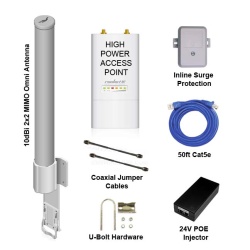Short Answer: YES, 2.4 GHz is still worthy.However, before we recommended exactly which package to use for fixing your campground Wi-Fi problems, we would need to know more. |
2.4 GHz can still be a viable option for Outdoor Wi-Fi at campgrounds, especially if the area is not heavily congested with other Wi-Fi networks. However, 2.4 GHz frequencies are more prone to interference from other devices, such as Bluetooth devices, microwaves, and other Wi-Fi networks, which can cause slower speeds or connectivity issues.
It’s also worth noting that newer devices may only support 5 GHz frequencies, which would limit their ability to connect to a 2.4 GHz Wi-Fi network. Additionally, if the campground has a large number of campers or visitors who are all trying to use Wi-Fi at the same time, the 2.4 GHz band may become congested and result in slower speeds.
Ultimately, the choice of which frequency to use for Wi-Fi at campgrounds will depend on various factors such as the number of users, the devices they are using, and the level of interference in the area. It may be worth considering using both 2.4 GHz and 5 GHz frequencies to provide the best coverage and performance for all users.
What is your incoming Internet speed to the park?
Is it gigabit or more? Then, you probably want to either go dual band to support the older legacy devices, as well as provide 802.11AC and 802.11AX for the newer, faster, bandwidth heavy clients, such as smart TVs, and the guests looking to game and/or stream at night. For this, we would recommend any number of our cloud based, 802.11AX packages.
If your internet connection to the outside world is only a couple hundred megabit, or less…then using a 2.4GHz Wi-Fi package will not only save you money, but we would throttle bandwidth, so that guests do not have unlimited capabilities. In fact, we would recommend limiting bandwidth even with the faster packages. A 2.4 GHz access point can still support up to 30Mbps to each device. So with the addition of bandwidth limiting, and the fact that 2.4 GHz gives you a wider, broader, stronger signal in the park…why not go with 2.4 GHz?
We were recommended a Wi-Fi package that included an older access point, like the RocketM2. Is that still ok to use for Outdoor Wi-Fi at our Campground?
The RocketM2 is a wireless access point that operates on the 2.4 GHz frequency and can be a suitable option for providing Wi-Fi at a campground, depending on the specific needs and requirements. One of the most popular, easy to install Wi-Fi packages at 2.4 GHz is the GNS-1585.
Some factors to consider when using the RocketM2 for campground Wi-Fi include the coverage area, number of users, and desired internet speed. The RocketM2 can cover a significant area with a line of sight, but obstacles such as trees and buildings can reduce its range. Additionally, the number of users that the access point can support effectively may depend on the specific use case and how many people are trying to connect at the same time.
In terms of internet speed, the RocketM2 can provide up to 150 Mbps of throughput, which may be sufficient for many campground Wi-Fi applications. However, if there are a large number of users or if high-speed internet access is a requirement, then additional access points and/or higher-end equipment may be necessary. You also want to make sure that bandwidth control is enabled somewhere on the network. Typically, with the addition of a commercial grade router, like the ER7206.
Ultimately, the suitability of the RocketM2 or any other access point for campground Wi-Fi will depend on various factors such as the size of the area to be covered, the number of users, the desired internet speed, and any obstacles or interference that may be present. It’s important to carefully evaluate these factors and select the appropriate equipment to ensure reliable and efficient Wi-Fi coverage for campers and visitors.
Will my guests be able to “Roam” throughout my park, and still be connected?
Yes, clients should be able to roam between 2.4 GHz access points, but the process may not be as seamless as it would be with newer Wi-Fi standards like 802.11ac or 802.11ax. Roaming refers to the process of a wireless client device switching from one access point to another as the device moves through a network, without losing its connection or experiencing a significant interruption in service.
In a 2.4 GHz network, roaming may take slightly longer due to the limited number of non-overlapping channels available. As a result, the client device may need to spend more time scanning for available access points and evaluating signal strength before it can make a seamless transition to a new access point.
However, with proper network design and configuration, it is still possible to provide a reliable and efficient 2.4 GHz Wi-Fi network that supports seamless roaming for client devices. This may involve deploying multiple access points in a well-planned layout to ensure optimal coverage and minimize interference, as well as configuring the network to support fast roaming protocols and minimize packet loss during handoff between access points.
Overall, while roaming may be slightly slower on a 2.4 GHz network compared to newer Wi-Fi standards, it is still possible to provide a reliable and efficient network that supports seamless roaming for client devices with the proper design and configuration.
GNS Wireless offers a range of customizable campground Wi-Fi packages designed to meet the unique needs of your outdoor space. Our team of experts can help you choose the best package and equipment for your specific requirements, ensuring reliable and efficient Wi-Fi coverage for your campers and visitors. Contact us today to learn more and get started.
Learn more about signal strength and dB loss here.


